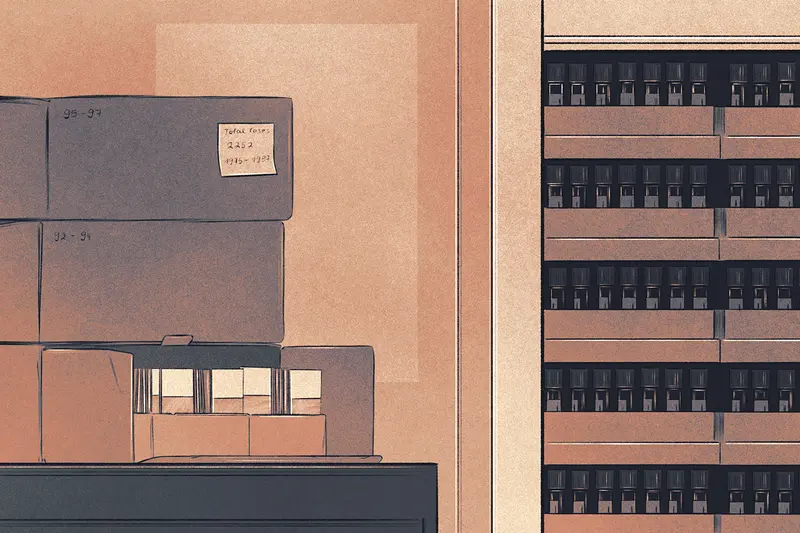ProPublica is a nonprofit newsroom that investigates abuses of power. This story was originally published in the Cold Justice newsletter, which goes behind the scenes of our three-part investigation into the outrage and promise of untested DNA from rape victims. You can sign up for the newsletter here.
It all began in 2016 with an email from a survivor. I was in the newsroom on the second floor of The Baltimore Sun, where I was working as an investigative reporter. My colleague Alison Knezevich and I received an email from a woman saying she had just learned that the Baltimore County Police Department had destroyed her rape kit.
How could that be, I wondered? I knew about the world of untested kits and fudged rape clearance numbers, but not about destroyed DNA.
I reached out to the woman and started a conversation. Alison and I also obtained data through public information requests and a standardized survey we created and sent to law enforcement agencies to understand the bigger picture. Was this isolated destruction or a trend? We published a report several weeks later, in December, that revealed hundreds of destroyed rape kits across the Baltimore region, plus a history of haphazard testing of rape evidence. Our article led to statewide reforms that mandated retention of rape kits for 20 years.
Through this reporting, I learned about Dr. Rudiger Breitenecker, the suburban doctor who had saved evidence from rape survivors for over two decades. The evidence led to several convictions. That dedication to preservation seemed the polar opposite of the patterns we had just published a report on.
Exactly how many convictions had resulted from this evidence? Why did the doctor save it all? Who was he?
That story piqued my interest, but it seemed, at the time, mostly historical. The practical realities for a reporter at a shrinking newspaper in a big news town means you don’t have time for historical stories. I had already begun other projects, including one about surging hate crimes, for which I would partner with ProPublica’s Documenting Hate project.
So I reported the Breitenecker story in my spare time, driving out to meet the doctor at his horse farm in Baltimore County in 2017. It wasn’t until 2019, when I took an extended leave from the Sun to fulfill a lifelong dream of watching the Women’s World Cup in France, that I had time to really dig in.
By then, I had obtained a list of men arrested as a result of Baltimore County’s cold-case DNA efforts, and I had started building a database tracking their criminal histories.
I thought it could be an important data set. Because “Dr. B,” as Breitenecker is known, started saving so early and the DNA wasn’t tested for so long, we had an unusually long window on the actions of suspected rapists.
Every morning before the soccer games, I sat at a cafe and typed arrestees’ names into the Maryland Judiciary case search and recorded their criminal cases in an Excel spreadsheet. I thought it would take a week. It ended up taking months. I was horrified as the pieces came together.
The criminal histories were far more extensive than I anticipated. The rape from which Dr. B collected evidence was often the beginning of a long criminal career of other rapes, assaults and even murders. It was like watching a horror movie in reverse. It left me feeling nauseated. After each criminal history search, I would run out my frustration. Could some of these have been prevented? I ran a lot during that time.
At the time, academic researchers were publishing their findings from processing tens of thousands of untested rape kits across the county. Their revelations were similarly jolting. They had also found serial rapists and murderers, but on a much greater scale.
At the end of my trip, the database was incomplete, but the picture of a story was coming together. A unique trove of DNA evidence had unearthed several serial rapists. I still needed to fill in the gaps in suspects’ rap sheets with paper court records and reorganize and code the types of crimes in a more robust database.
I also learned two important twists that made this story urgent in my mind. First, only a fraction of the DNA saved by the doctor had been tested, which not even the doctor knew. The rest remained at the hospital.
Second, I met with the doctor after the trip and he joked about his coming demise. Such was his deadpan humor, as I was about to learn from his colleagues. But it was rooted in truth.
He was about to turn 90 and was on dialysis. I wanted to document and report the story before the window closed with the doctor, the survivors or the perpetrators. I left my full-time job to dedicate myself to the project.
And then in October 2019, the Baltimore County government announced that it would begin testing the doctor’s DNA collection again. We had the chance to record history.
I partnered with John Benam, an award-winning documentary cinematographer who had filmed several other Baltimore projects (PBS’s “Charm City” and Netflix’s “The Keepers”) and we pulled out our cameras for the first time to record the announcement. We thought it would be an uneventful presser.
Then a woman in the audience asked questions of the officials. It had been a decade since the doctor’s trove of DNA had proved that her rapist was a serial predator. She did the math. The grant money being announced would only cover testing a small batch. Why weren’t police testing all of the evidence? The local news cameras turned toward her. Who was this woman? She was Laura Neuman, and we were about to learn much more about her and her case.












